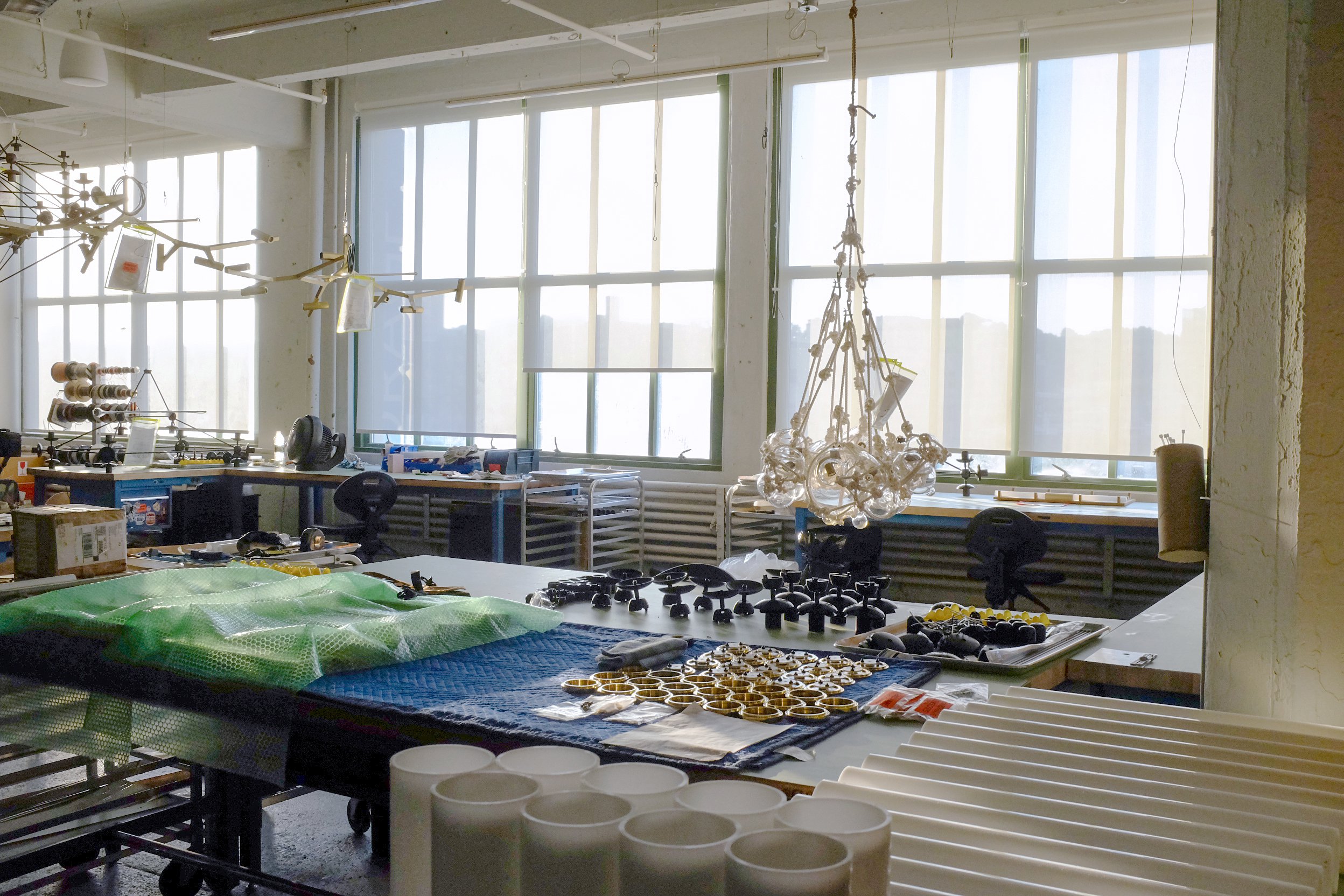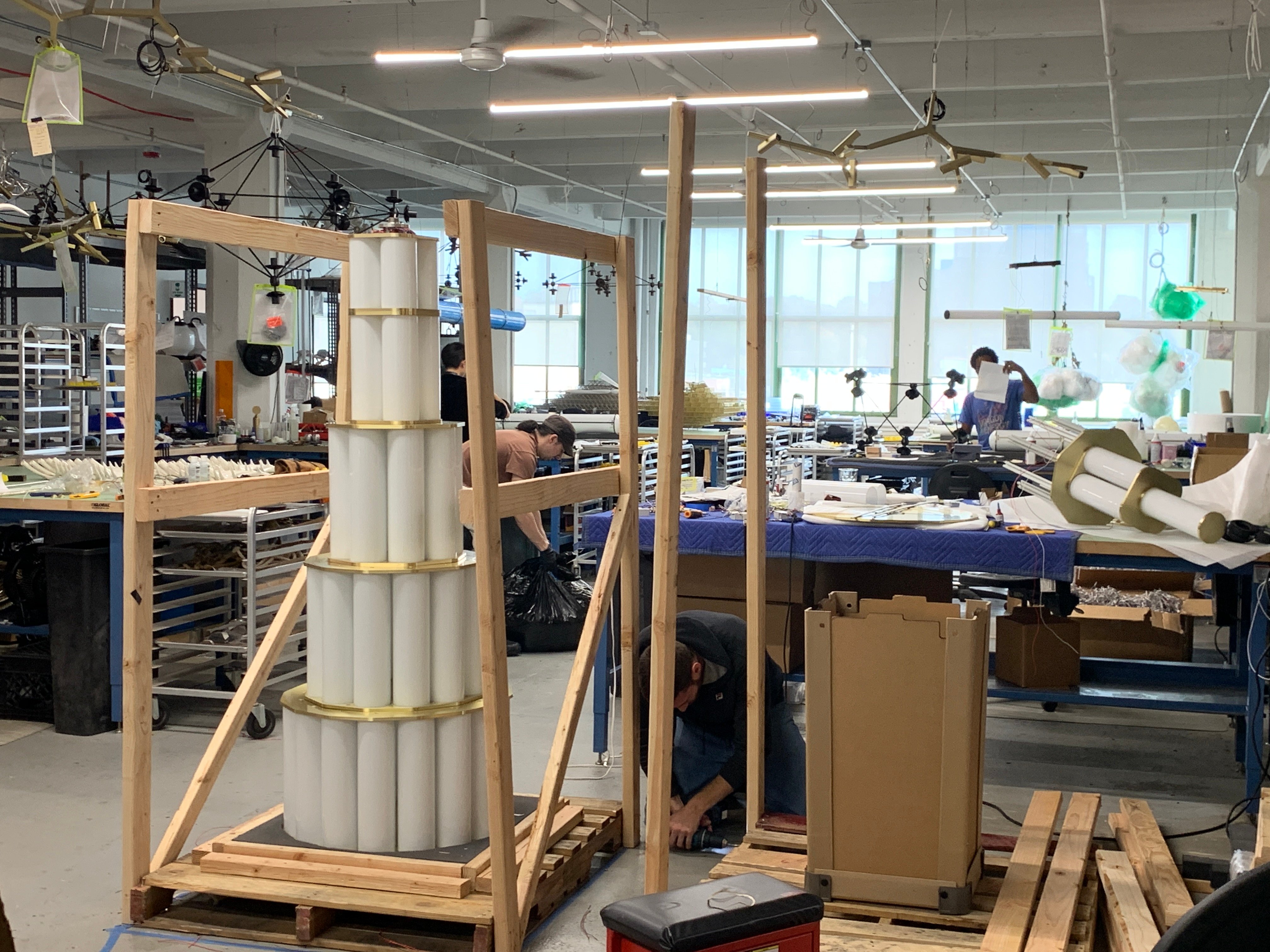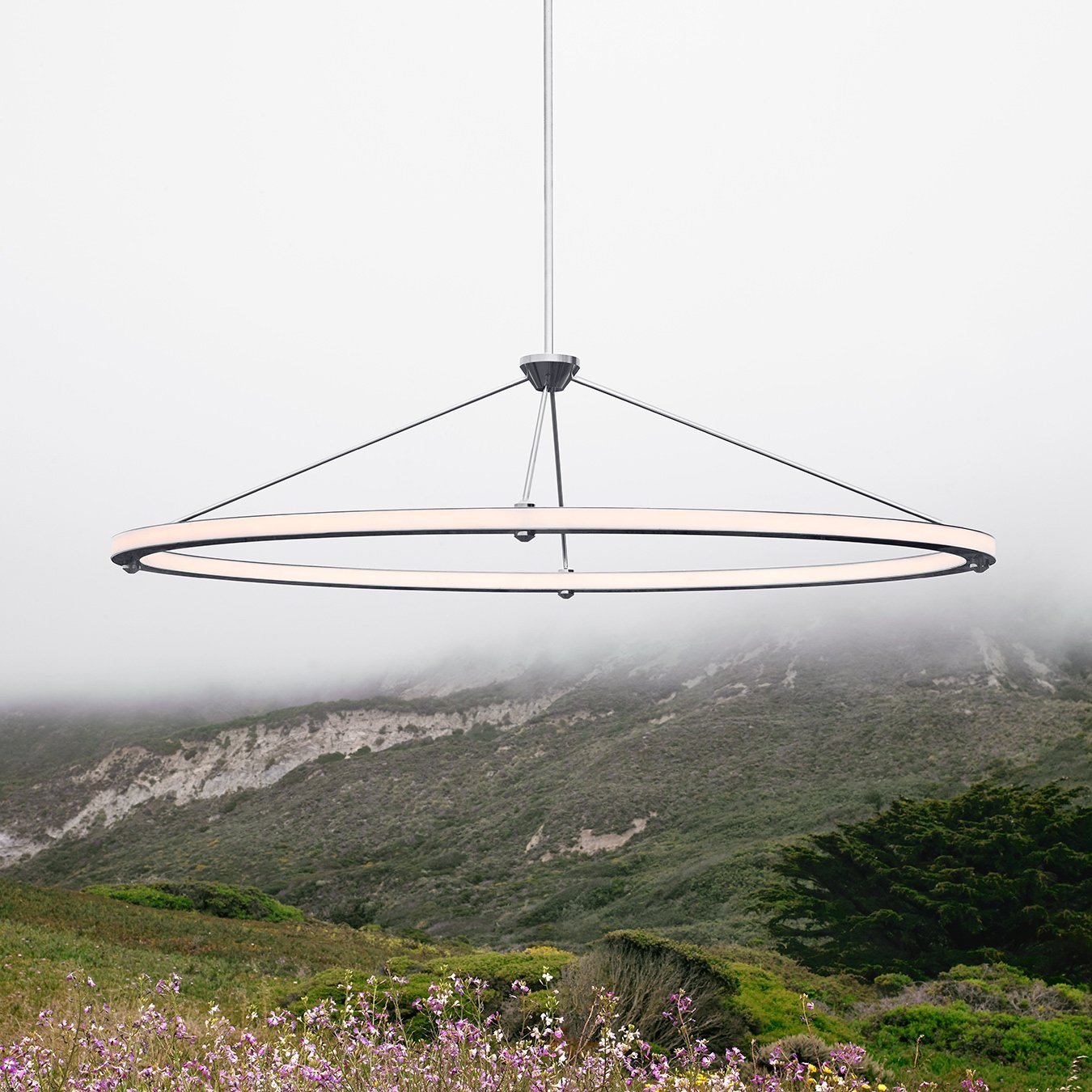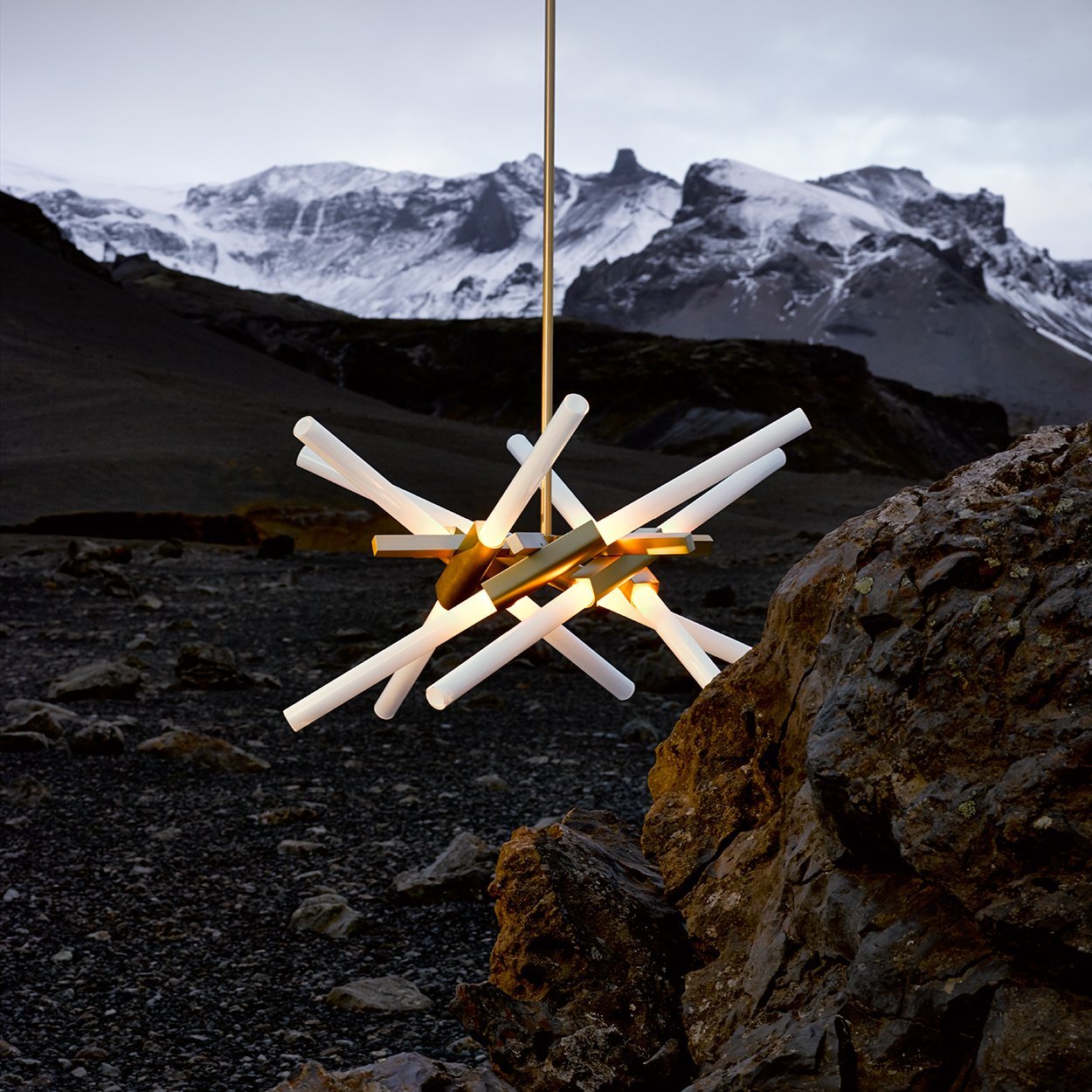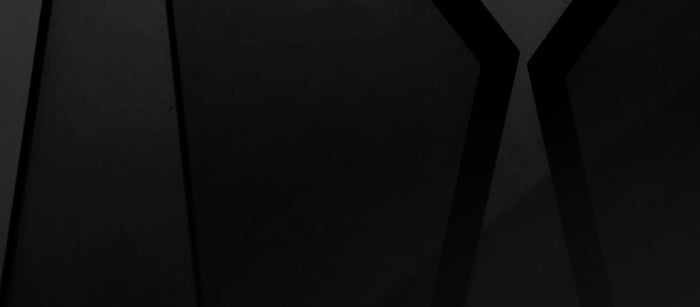
Jason Miller, founder and creative director of New York lighting company Roll & Hill, spoke with More Space about navigating the challenges of New York's shutdown and the impacts to his design business, how he is balancing home life and work life and using the logic of design to get through, and the next radical move for Roll & Hill.
More Space: Thanks for joining us Jason. How are you and how are things in New York?
Jason Miller: New York was shut down for 11 weeks and we have just opened up, so we are back working in our studio on a limited schedule. Before that, we were completely shut out. We were working at home but the work that had to get done in the factory, which effectively was making lamps, was put on hold and that was difficult. We could exercise and go shopping and we could drive around for something different. The cases are now down and there's room in the hospitals again. One of the unique things about the US Is that there are 50 different states and they they do operate independently quite a bit. In New York people definitely took it seriously, but some other parts of the country never shut down and some states shut down for a month and then kind of went back to business. It was very different throughout the country.
When New York initially shut down, we had to lay off half of our employees, or technically furlough half of them, because we didn't know what was coming next and we had to make the tough choices to live. About a month or maybe six weeks into it, the government came up with some pretty substantial aid for companies like us, so we were lucky we received that fairly early on and we were able to hire back all of our employees pretty quickly. Once we were back to full staff, it was kind of a unique time to get a lot of work done without having to keep up with the day-to-day of getting products out the door. So it turned out to be a fairly productive time for things like product development and internal projects within the company.
You work with designers, makers and suppliers all around the world, what have been some of the challenges?
We get a substantial amount of glass made in Italy, a lot of electronics parts are made in China, and then various other things made all over the US. So, I think for any manufacturing company one of the big hurdles to get over was, and probably still is, not just how to get the factory open but how to get the supply chain up and running, Another sort of unexpected offshoot of this, is that international shipping is almost impossible these days. Even if a factory is making the thing that we want in Italy or China, getting it to the United States is really hard. There are no airplanes flying. There are ships but we are not always buying a container full and if we want a small box of stuff, those shipments would normally go on commercial airlines in the cargo holds, but with no commercial flights there is a huge reduction in the capacity of shipping. So it’s been interesting.

Jason Miller's Brooklyn home became his studio during lockdown in New York. Photo c/o Jason Miller.

What does a day at the office look like for you right now?
Well, this is my desk. So I sit here and work which could be worse. You know, I think one of the interesting things about it is I have a two year old and a 9 year old, and there's no childcare, so like a lot of my employees, the day is not just going to work for 8 hours and going home. You're trying to juggle those two things at the same time. From a practical perspective I can get a few hours here and there of work but there's always a kid running around, a diaper that needs to be changed, or school work that needs help with, or something other than work to do (laughter).
So, a balance between work, being a dad, cooking and all the things that go with that?
Exactly. I think for my girlfriend and me, the biggest frustration is having to clean up after the kids eight times a day, and oh my God it’s relentless.
How do you stay connected with the Roll & Hill team?
With Google Chat, that's our go-to, and phone calls. That's pretty much how we've been running things.
And how did you keep up morale and stay sane during that time?
I get some free time in the morning, like right now I can go outside and drink my coffee and the kids are watching cartoons and eating breakfast. I get a little headspace in the morning when I try to get the bulk of my work done, so between now and lunchtime, that leaves me the afternoon to be freer so I can be a more responsive father which I think is good.
What projects have you been working on, and had you planned to launch anything at the Milan Furniture Fair in April?
Not really for Milan, but we had a number of things in the works. The lighting fair in Milan is every other year, so this was an off year for us and we we were going to be visitors only, so we didn't miss too much in that regard. In February, we purchased a furniture factory in Michigan which has been a big thing for us, so we were in the process of getting that up and running when the shutdown happened. We managed to finish that off and we now have a fully operational furniture factory and the idea is that we will develop a furniture collection. As a designer, my intention was never to be a lighting specialist (laughter).

The Bluff City lamp designed by Jonah Takagi for Roll & Hill. Photo c/o Roll & Hill.
"Design is about problem solving and we try to integrate that into the company itself. So certainly from that perspective, the logic of design was something that we were using to get through this."
Jason Miller, Founder and Creative Director, Roll & Hill
Do you think this crisis might shift the way we will work into the future?
I tend to be a little bit dubious about that. I know there's a lot of talk and people have experimented with virtual offices or disconnected offices for a long time, probably going back to the 1980s and even into the 70s. But they always come back around to everyone sitting in a room at some point. So, certainly in the short term it will have a big effect. I know that for us, there's no plan for our office staff to go back to work. We need to have the factory working on location that's just the nature of the job, but at the very earliest our office people are not going to be back until September and likely longer than that. Certainly in the short term, we're all going to be working virtually and that will be interesting and different but long-term, 5 or 10 years down the road, I still believe that there’s value in being with people, sharing a space, talking with the team off the cuff, as opposed to having to schedule a meeting. So, I think there's real value in being in a workplace together. Maybe that's not 40 hours a week, but I think there's something to it.
Those water cooler moments are important, as well as serendipity and all the things that come with working together.
Yes, we were joking about kids but it's a real thing. If you're trying to juggle home life and work life at the same time on an ongoing basis, I can say for myself, I'm less productive.
What have been the most challenging things for you from a business perspective?
The bigger picture without a doubt. When this all started we had to come up with a plan to keep the company alive within a matter of days. I can't overemphasise how ridiculous that proposition was back in March. Forget about the virus for a second, if someone says to you, okay, you are not allowed to make any products for the next eleven weeks which effectively means that you're not allowed to make money for 11 weeks. How are you going to keep your business going? That's not even a remote possibility in a normal circumstance and no one's thought about it, no one has a back-up plan. We were making everything up from scratch on the fly. We’d make up a plan in the morning and then by the afternoon it was irrelevant. So that two week period, right before the full shutdown when we were trying to figure out like how dramatic it was going to be and how we were going to make it through, that was a crazy time.
How do you approach a plan like that?
We essentially set out three steps, like bad, worse and really worse, and we took it step by step and luckily we landed on the middle step. We were then able to go back to the less severe step once the government came up with some aid so we never got to the most draconian plan.
"I don't think we're really going to change what we do, I'm not sure that there's a reason to do that. We were already preloaded with a radical change by buying a furniture factory in February so for us, that is a real radical rethinking of the business in itself."
Jason Miller, Founder and Creative Director, Roll & Hill.
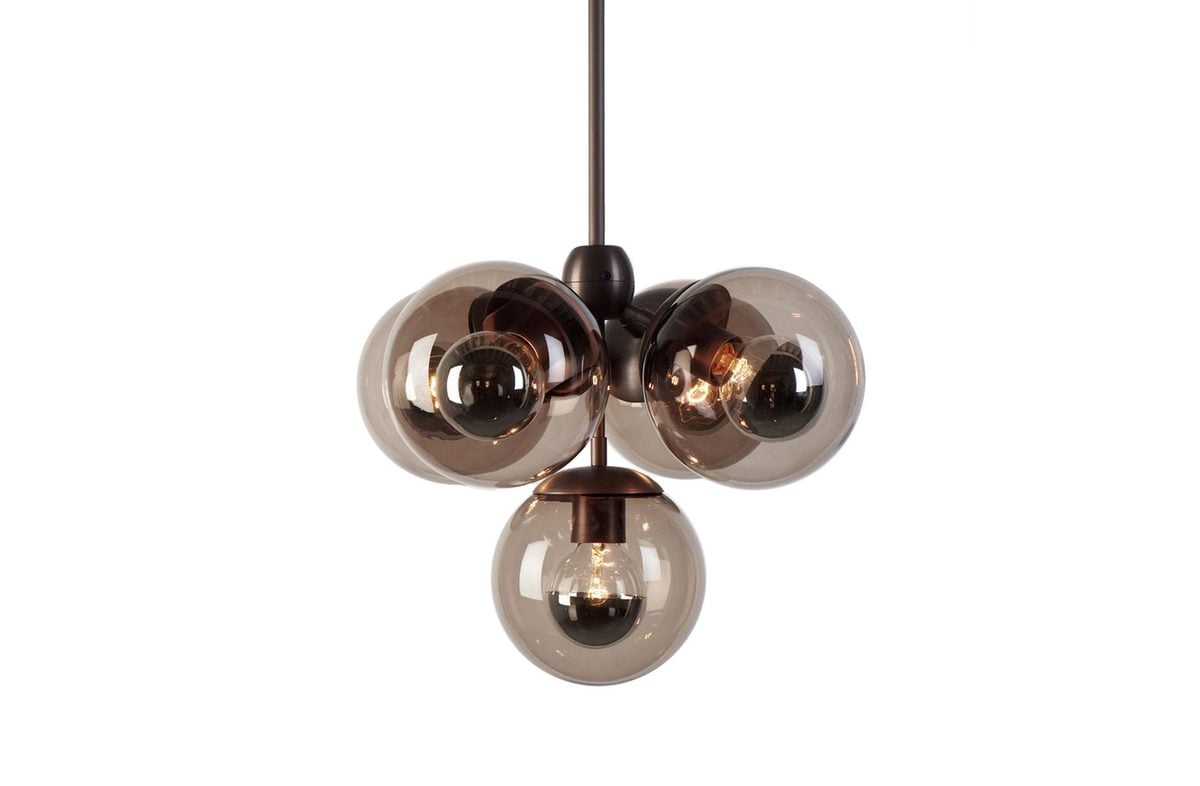
The Modo collection designed by Jason Miller for Roll & Hill was inspired by the idea of ready made components. Photo c/o Roll & Hill.
What has the pandemic taught you as a designer and also as a business owner?
I could get political but perhaps it’s not the right moment. It was certainly a difficult moment and we're not through it yet. One of the things that we are most concerned about is the fall. It's great that everything's opening up right now and we've got a lot of work to do because we've been shut down but you know, if people aren't buying lights, if there is a second wave or something in the fall, if those two things coincide, I don't know if we can withstand a second bout of this. So I don't want to downplay it and and say that the problem is solved and everything's normal again, but I do think that the ability for people to come up with solutions in real-time and get to the other side, there has to be some optimism in people's ability to be flexible and business’s ability to be flexible, and to be creative and solve problems that you didn't know were coming. Design is about problem solving and we try to integrate that into the company itself. So certainly from that perspective, the logic of design was something that we were using to get through this.
As things improve in New York and the city opens up further, are you planning any changes within the company?
I think there will probably be some things that we do as a company that will be different. As I said in in the near term, at least three to six months we're all going to be working virtually with the exception of the factory. So that's a real thing, that's not just a temporary thing. So we're all gonna have to figure out how to do that and what that means going forward. From a design perspective, I don't think we're really going to change what we do, I'm not sure that there's a reason to do that. We were already preloaded with a radical change by buying a furniture factory in February so for us, that is a real radical rethinking of the business in itself. I’m not sure that we're going to throw another bunch of things on top of that.
Tell me a bit more about that decision and that radical shift for Roll & Hill.
I think in the 10 years since I started Roll & Hill, it's been successful and people have responded to the products that we have put out and we have a really great team of people together. There’s been a lot of talk for several years about how to expand. There were a number of options on the table and at the end of the day furniture seemed like the best progression for the company. Same customer base, same idea about production, same general creative direction, just with a different type of product line.
A year and a half or two years ago, we started focusing on that as the next step and trying to figure out what the right springboard would be to do it. We knew we couldn't start developing production from scratch, It's just too big of a hurdle frankly. It took eight years to really figure out how to make lights in volume and we knew that we didn't have the opportunity to fumble through that a second time. People are forgiving when you are a new company and you're cute and interesting and fresh, but people weren't going to accept a six-month long delay if they ordered a table from Roll & Hill. We knew we had to start with some amount of production already and the way to do that was to find a company, or a factory, that could do what we wanted to and purchase it.
The company we bought has been in business for 70 years and they specialise in making wood chairs at reasonable prices and I think a lot of people would be surprised that even existed in the US. The factory is located in Grand Rapids, Michigan, which used to call itself Furniture City USA. It's where Herman Miller is based, Steelcase, and Hayworth, three of the largest furniture companies here. So there's a whole ecosystem of furniture factories there and that was another thing that was appealing.
What will be the design approach to the new Roll & Hill furniture collection?
Our key markets have always been residential and hospitality. When I started Roll & Hill, the creative direction had kind of a simple mission which was to make well designed lights for the American market which 10 years ago was a real novelty. The three biggest design lighting companies in the world were all Italian and they all had a very similar aesthetic and it felt a little bit alien to Americans. So that was the proposition. We would make things that appealed to Americans but were also considered good design on an international level. I think that hole exists currently in the furniture market so our creative mission is not going to change at all.
How is the collection taking shape?
We have been working with four designers to develop products for the Roll & Hill furniture line and some of the pieces will be mine. I'd love to say we could launch some pieces in the fall, but that might be a little bit ambitious. But hopefully before the end of the year we'll get a collection out to the market.
In Italy, the design industry has stood together to support one another during the crisis, has this also happened in New York?
We have all been working in our own little bubbles but I think there's been mutual support within the industry definitely. One of the interesting things that has come back is just the simple idea of making a phone call. I can remember back in the late 90s before the internet was ‘the' thing out there, way before smartphones, you’d call your friends and talk to them and I have found that it's come back a little bit which frankly has been kind of nice.
Thanks so much Jason, great to chat with you and take care.
The Roll & Hill collection is available exclusively in South East Asia from Space – Asia and Space – Australia.

